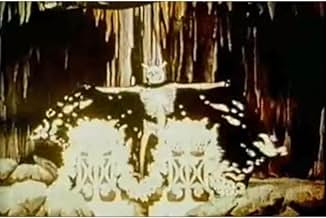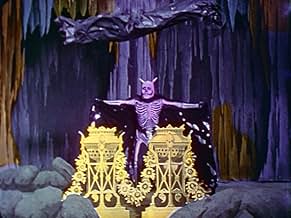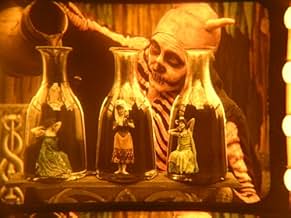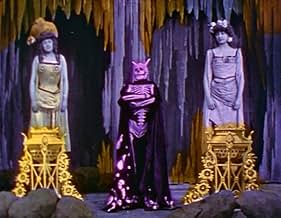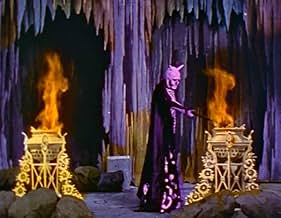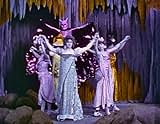CALIFICACIÓN DE IMDb
6.5/10
1.3 k
TU CALIFICACIÓN
Agrega una trama en tu idiomaA demonic magician attempts to perform his act in a strange grotto, but is confronted by a Good Spirit who opposes him.A demonic magician attempts to perform his act in a strange grotto, but is confronted by a Good Spirit who opposes him.A demonic magician attempts to perform his act in a strange grotto, but is confronted by a Good Spirit who opposes him.
Opiniones destacadas
Also, the story for this is somewhat confusing; if I hadn't seen the brief plot summary on Letterboxd, I wouldn't know (until near the end anyway) that this was about a Good Woman fighting the devil or a demon of hell or whoever this guy in a robe and skull-face is. It seemed if it was about a woman who might have even been this demon's boss, or maybe even some annoying underling, screwing with this Demon-Man has a penchant for bottling up women (literally, you can see this in full close-up, and that's how it seems - a full 8 years before Griffith did it in in Birth of a Nation you get a close-up, albeit in camera and with separate shots without a cut).
But at any rate, this is a fun short because the filmmaking is clever and inventive: we're seeing the process this devil takes with his female wares/prisoners, and it's through blazing red and orange colors (thanks silent film technology!) and with a magician's eye for trickery. By the end 'good' does prevail, but the joy is in the evil, if that makes sense; it's filmmakers reveling in the villainy of this Demon, or at least playing with the line between showing something as being *bad* as in a devil, or something that is... enjoyable to do, like, uh, bottling up women and making them prisoners. Or slaves. Or, I don't know what. This is simply cool, and it also empowers women to fight Satan's ways at the end of it all! How to do that, well, don't look at this for answers to that question, just watch magic tricks!
But at any rate, this is a fun short because the filmmaking is clever and inventive: we're seeing the process this devil takes with his female wares/prisoners, and it's through blazing red and orange colors (thanks silent film technology!) and with a magician's eye for trickery. By the end 'good' does prevail, but the joy is in the evil, if that makes sense; it's filmmakers reveling in the villainy of this Demon, or at least playing with the line between showing something as being *bad* as in a devil, or something that is... enjoyable to do, like, uh, bottling up women and making them prisoners. Or slaves. Or, I don't know what. This is simply cool, and it also empowers women to fight Satan's ways at the end of it all! How to do that, well, don't look at this for answers to that question, just watch magic tricks!
The Red Spectre (1907)
** 1/2 (out of 4)
Mildly entertaining French film from director Ferdinand Zecca was clearly influenced by the work of Georges Melies. In this film, in what appears to be Hell or something like it, a skeleton brings to life a couple women and then begins to do various tricks with them. That's pretty much everything you need to know in regards to the story as everything else is just one trick after another. There are a few good things about this film but at the same time it's just so easy to see that it's no where near the league of Melies and you have to feel that the French master was doing this type of film a decade earlier and doing it much better. I think the biggest problem is that there's really no strong pacing and after a while the 9-minute running time just feels like it's dragging along. There are several of the tricks, which simply aren't that entertaining and for one good example just check out the one where the skeleton wraps a woman up in some sort of tarp. How the trick was done is easy to spot. There are some good things however and this includes the scenery, which is quite nice to look at. The biggest highlight has to be the very good tinting and especially the reds.
** 1/2 (out of 4)
Mildly entertaining French film from director Ferdinand Zecca was clearly influenced by the work of Georges Melies. In this film, in what appears to be Hell or something like it, a skeleton brings to life a couple women and then begins to do various tricks with them. That's pretty much everything you need to know in regards to the story as everything else is just one trick after another. There are a few good things about this film but at the same time it's just so easy to see that it's no where near the league of Melies and you have to feel that the French master was doing this type of film a decade earlier and doing it much better. I think the biggest problem is that there's really no strong pacing and after a while the 9-minute running time just feels like it's dragging along. There are several of the tricks, which simply aren't that entertaining and for one good example just check out the one where the skeleton wraps a woman up in some sort of tarp. How the trick was done is easy to spot. There are some good things however and this includes the scenery, which is quite nice to look at. The biggest highlight has to be the very good tinting and especially the reds.
The first decade of the twentieth century saw the production of dozens of brief "trick films" which pushed the boundaries of the new medium, and France was the capital of this activity. Georges Méliès is the best known creator of these films, but The Red Spectre, which was produced at the Pathé Studio as a collaboration between Méliès' fellow pioneers Ferdinand Zecca and Segundo De Chomon, is perhaps the most bizarre and fascinating of them all. Or at least, allowing for the fact that so many of these films are lost, it certainly ranks with the best of the survivors. It is better seen than described, genuinely dreamlike in its images and transitions, and quite strange, but quite satisfying as well. The action lasts only about 8 or 9 minutes, but when it's over you feel as if you've been permitted to visit another world. When The Red Spectre was first exhibited the black & white footage was hand-colored to produce a dazzling effect, and happily, this material survives: a color print was discovered in a junk-yard in Mexico, and purchased for $25.00!
Our setting is a mysterious underground grotto, and our "host" is a demonic magician who seems to be toying with the souls or spirits of several captive women. He causes them to levitate, then burst into flames; he captures their ashes in bottles, brings them back to life in miniaturized form, etc. The magician is opposed throughout by a Good Fairy who resembles Peter Pan (portrayed by a woman, as Peter traditionally is on stage). The precise meaning of the action is difficult to determine at times, but the central conflict amounts to a struggle between the forces of Good and Evil.
One effect is especially notable: when the wicked magician produces three glass bottles, each holding a tiny woman prisoner, and brings them downstage to allow for a close-up, the scene instantly reminds latter day viewers of a similar sequence in The Bride of Frankenstein (1935). Did James Whale see this film, or is the similarity a coincidence? Notable, too, is the depiction of a device very much like television-- strongly suggested by the evil conjurer's magic screens, each of which depicts a series of moving images. Here's a real cinematic milestone: a film that predicts the coming of T.V., and, on top of that, attributes its invention to a demon!
Our setting is a mysterious underground grotto, and our "host" is a demonic magician who seems to be toying with the souls or spirits of several captive women. He causes them to levitate, then burst into flames; he captures their ashes in bottles, brings them back to life in miniaturized form, etc. The magician is opposed throughout by a Good Fairy who resembles Peter Pan (portrayed by a woman, as Peter traditionally is on stage). The precise meaning of the action is difficult to determine at times, but the central conflict amounts to a struggle between the forces of Good and Evil.
One effect is especially notable: when the wicked magician produces three glass bottles, each holding a tiny woman prisoner, and brings them downstage to allow for a close-up, the scene instantly reminds latter day viewers of a similar sequence in The Bride of Frankenstein (1935). Did James Whale see this film, or is the similarity a coincidence? Notable, too, is the depiction of a device very much like television-- strongly suggested by the evil conjurer's magic screens, each of which depicts a series of moving images. Here's a real cinematic milestone: a film that predicts the coming of T.V., and, on top of that, attributes its invention to a demon!
In 1907, we all agree, cinema audiences could be easily amused, so to say. But even today, to look at the pioneering cinema ways used to trick the human mind is somewhat fascinating. I, myself, get more of a kick from watching these old fashioned movie magicians than in a live magic show where everything is overdone. Here, the camera is still, Satan is a guy in a Halloween costume - but see how the frame is used to its fullest, the sets are so creepy and the eerie atmosphere kicks off right away, when we see a twirling coffin magically appear, and the magic show begins.
A treat for all fans of novelty early cinema.
A treat for all fans of novelty early cinema.
This is one of the weirdest films I've ever seen from the filmmaker Segundo de Chomón--and much of this is because the film is set in Hell and the leading man is the Devil himself! Interestingly, he looks much more like a skeleton than 'Ol Scratch and he is bored. In fact, he's so bored that he decides to put on a magic show! Assisted by his main squeeze (Julienne Mathieu--the director's wife), the Devil does one trick after another after another. In fact, there are so many that it's fatiguing. It's much like watching three or four of Georges Méliès films (who Chomón is clearly copying from) and stringing them into one long film.
The film has some serious pluses--nice costumes, terrific sets and a weirdness that is wonderful. A huge minus that Chomón isn't innovating here but is 'copying' the work of another man--using a lot of the tricks innovated by Méliès. Fortunately, however, he still manages to make a very nice film.
The film has some serious pluses--nice costumes, terrific sets and a weirdness that is wonderful. A huge minus that Chomón isn't innovating here but is 'copying' the work of another man--using a lot of the tricks innovated by Méliès. Fortunately, however, he still manages to make a very nice film.
¿Sabías que…?
- TriviaHas a link to the Ulli Lommel's Zodiac Killer (2005) case. A letter allegedly sent by the Zodiac Killer, who may have been a film buff, was signed "The Red Phantom" and could have referred to this film or to the color "Masque of the Red Death" sequence in Lon Chaney's 1925 El fantasma de la ópera (1925).
- ConexionesFeatured in Hollywood (1980)
Selecciones populares
Inicia sesión para calificar y agrega a la lista de videos para obtener recomendaciones personalizadas
Detalles
- Fecha de lanzamiento
- País de origen
- Idiomas
- También se conoce como
- The Red Spectre
- Productora
- Ver más créditos de la compañía en IMDbPro
- Tiempo de ejecución9 minutos
- Color
- Mezcla de sonido
- Relación de aspecto
- 1.33 : 1
Contribuir a esta página
Sugiere una edición o agrega el contenido que falta

Principales brechas de datos
By what name was Le spectre rouge (1907) officially released in India in English?
Responda
